Native Archaic Period
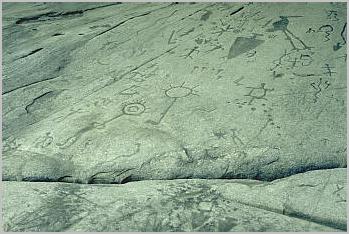
Native Canadian Petroglyphs Photograph © Harvey Kirsch
Nicholas R. Adams
As the ice retreated north, the climate became more moderate. People spread out across the land, adapting their lives to the gradually changing conditions.....
As the glacial ice continued to recede, the climate gradually became milder and more land became available for exploration and occupation. The Archaic Period spans the long time between the end of the Palaeo-Indian Period and the beginning of the use of pottery in Ontario (at about 900 B.C.). During the 6,500 years of the ARCHAIC PERIOD the exquisite stone tool workmanship of the Palaeo-Indian period was slowly abandoned. Archaic spear-points rarely reach the quality of workmanship of those of their forebears and are made from a greater variety of rocks. The Archaic period was one of long and gradual change. The long seasonal migratory movements of the Palaeo-Indians seem to have been abandoned as Archaic people focussed more closely on local food resources. They modified the equipment they made to cope with the transition from an open sub-arctic landscape to a more temperate, forested one. Archaic people began to make a wide variety axes, hammers and other tools by pecking and grinding rocks to the desired shape.

New Age Drawing Corel Corp
Some of these were used for wood working, other were used to process wild plant foods such as nuts and berries. During the later part of the period, Archaic people also made a variety of highly polished stone tools. Some of these may have been simply decorative - others may have been used as counterweights for spear-throwers. These technological changes show that Archaic people slowly modified their lives and equipment to help them cope with the changing world within which they lived.
EARLY ARCHAIC LANDSCAPE
By about 10,000 years ago, much of southern Ontario was covered by an open forest of jack pine and red pine. In exposed areas the forest would have been sparse, in more favourable and sheltered areas, a denser forest cover would have existed. Over the next thousand years, white pine and such deciduous species as elm, ash, poplar, birch and oak gradually infiltrated into the region, replacing much of the coniferous forest. Thus Early Archaic people occupied a region of mixed forest.
During the Early Archaic Period (ca. 10,000 - 8,000 B.P.) levels in the Lake Erie, Lake Ontario and Lake Huron basins were much lower than today. Archaeologists assume that many of the campsites which were oriented to the lake shore are now under water. Until recently few Early Archaic finds had been recognized in Ontario. It had been assumed that populations were low and that the region was incapable of supporting even a moderate population. This picture is gradually changing as more Early Archaic artifacts are being recognized in museum and private collections throughout southern Ontario. The mixed forests of the Early Archaic period appear to have supported most of the animal and plant species present in the region at the time of historic contact (ca. A.D. 1650).
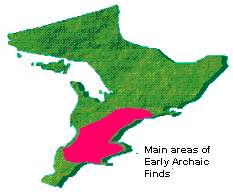
Early Archaic sites and finds of Early Archaic artifacts are uncommon everywhere in Ontario. They are most numerous near the north shore of Lake Erie, and along the north shore of Lake Ontario. The frequency of finds drops off rapidly to the north of these areas. Very few Early Archaic finds have been reported beyond the area marked on the accompanying map.
MIDDLE ARCHAIC LANDSCAPE
By 8,000 years ago, southern Ontario was covered by a mixed deciduous / coniferous forest. Generally the pattern was similar across southern Ontario, although in the east, changes tended to occur later than in the west, with conifers remaining the dominant species.
Hemlock became the dominant conifer over much of the region, while hardwood species such as oak, elm, maple and ash gradually became more common. Some researchers have noted that many of these latter species were nut-bearing trees. This would have been an important food resource for people living in the region.
During much of the Middle Archaic period average temperatures may have been slightly warmer than today. There would have been few constraints on settlement and use of the region. The relatively low numbers of known archaeological sites in the area is probably because Middle Archaic materials have not been recognised, and that many of the most likely areas for settlement along the lower Great Lakes shores are now under water.
The Early Middle Archaic is poorly known. Finds of artifacts of this are are restricted to southwestern and southcentral Ontario. They do not seem to occur far north of the lower Great Lakes. The later Middle Archaic is better known. Archaeological sites of the Laurentian Archaic occur at a number of locations in eastern Ontario, notable on the Ottawa River and in the Rice Lake area. Other Middle Archaic materials, not directly attributable to the Laurentian Archaic, yet similar in many ways, have been found throughout southwestern Ontario.
LATE ARCHAIC LANDSCAPE
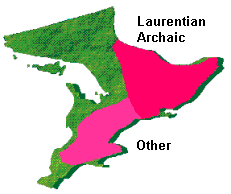
By the beginning of the Late Archaic Period (ca. 4,500 B.P.) conditions over much of southern Ontario had become similar to those encountered today. Mixed forest dominated most of the region, with nut-bearing hardwood trees being abundant in southcentral and southwestern parts of the province, and less abundant in the east. The climate was similar to, or perhaps slightly warmer than we experience at present.
At the beginning of this period, water levels in the Upper Great Lakes were higher than they had been since Lake Algonquin times. Lake Nipissing occupied the whole of the Upper Great Lakes basin. As time passed, water levels gradually fell, thus, for the first time, we have a fairly complete record of the human occupations during this period. Generally, conditions in Ontario were favourable for human settlement and exploitation.
The distribution of Late Archaic Narrow Points is poorly known. Points of this type appear to occur throughout the region, although true 'Lamoka' sites are only known from the Niagara Peninsula and the Grand River Valley areas.
Late Archaic Broad Points occur throughout the region. They are common in southwestern and southcentral Ontario, but have also been found in large numbers in the Rideau Lakes area of eastern Ontario. Some Broad Point types such as Genesee and Adder Orchard seem to be more common within the Carolinian Forest Zone, although Genesee Points have been found as far north as Sault Ste. Marie.
The distribution of Late Archaic Small Points is very poorly understood. These rather non-descript points have been studied most closely in southwestern Ontario where four distinct types have been recognized. Related types are almost certainly present over the rest of the region, but have yet to be formally described.
NORTHERN ONTARIO LANDSCAPE
With the gradual melting back of the glaciers (between 10,000 and 8,000 B.P.) a brief period occurred when tundra vegetation dominated the landscape. This ground cover of mosses, sedges and other hardy species was soon superceded by spruce forest. By 7,000 years ago, spruce forest, similar to that which cloaks much of northern Ontario today, covered much of the region.
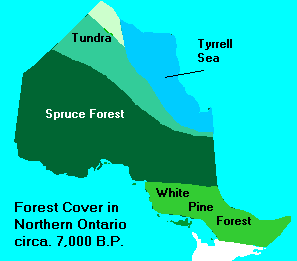
Average annual temperatures had been gradually climbing since the retreat of the ice. They peaked at about 5,000 B.P. when average temperatures were approximately 1 or 2 degrees above those of the present. Encouraged by the milder climate, white pine gradually replaced spruce as the dominant species over much of the southern part of northern Ontario. This 'white pine maximum' occurred at about the same time that water levels in the upper Great Lakes were at their highest during the 'Nipissing stage'.
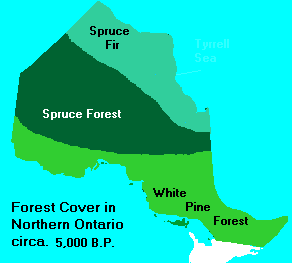
After about 4,500 B.P. annual temperatures gradually declined until the cooler, wetter climate comparable to that of the present was reached about 3,000 years ago. The range of white pine gradually retracted to its current distribution.
Numerous Archaic period sites occur within the region of the 'White Pine Maximum'. On many of these sites, large, heavy gouges and adzes have been found, such as the Early Archaic 'Trihedral Adze'. These are thought to have been used for working wood, and perhaps in the manufacture of dugout canoes.
THE SIDE-NOTCHED HORIZON (10,000-9,700 B.P.)
Side-notched points are common throughout Ontario prehistory, so distinguishing Early Archaic points is not easy. Points from this period share many Late Palaeo-Indian characteristics such as base grinding and basal thinning. Some have concave bases like Late Palaeo-Indian points. In addition, many Early Archaic Side-Notched points have bevelled edges or edge serrations.
So far few points from this horizon have been identified in Ontario. To the south of the Great Lakes side-notched points given various type-names (such as Hardaway Side-Notched, Greenbriar, Big Sandy) have been found on sites dating to just after the Late Palaeo-Indian period.
The side-notched point horizon in Ontario may represent a transitional stage in the manufacture and use of spear or projectile points from the carefully executed Palaeo-Indian spearpoints to less well made points of the later Archaic period.
THE CORNER-NOTCHED HORIZON (9,700-8,900 B.P.)
Throughout northeastern North America, a tradition of medium to large corner notched points has been recognised. To the south of the Great Lakes points of this type have been found in well dated, stratified deposits, thus their chronological position is well known. Although similar dates are not presently available for Ontario examples, they are estimated to date to the same time.
Points from this horizon tend to be well made, with thin blades and narrow, relatively deep notches. Many are bevelled with the bevelling present on alternate sides, as if the point blade had been rotated in a shaft to sharpen it. Almost all of these points are serrated. The predominant blade shape is leaf shaped, although they are quite variable, perhaps reflecting frequent re-sharpening.
The discovery and excavation of the Nettling Site in southwestern Ontario has markedly increased our knowledge of this period. Numerous serrated, corner-notched points have been recovered from this site, along with many other forms of artifact. These have allowed archaeologists to gain a much more complete picture of the variety of tools used by these people.
In addition to the points, both end and side scrapers were found, although side scrapers are less common than on earlier sites. Other tools include triangular bifaces, drills, concave side-scrapers and numerous flake tools. Lastly, a number of rough choppers or scrapers made of soft sedimentary rocks were found at the site. Some of these have been ground or roughly flaked then ground.
The people occupying the Nettling Site used a wider variety of raw materials for making stone tools than their predecessors. Although high quality chert (particularly Ohio Pipe Creek chert) was used for many tools, local cherts from till were quite common tool materials - a situation which has not been noted at Palaeo-Indian sites.
THE BIFURCATE HORIZON (8,900-8,000 B.P.)
Bifurcate points are a distinctive Early Archaic point form found across the central part of the North American continent. These points, which have been dated to the period between 8,900 and 8,000 B.P. are easily recognized by the presence of a deep v-shaped split or notch in the centre of the base. The actual base form may vary from broad, almost corner-notched shapes, to a much narrower stemmed shape. They all share the characteristic basal indentation.
In common with other Early Archaic forms these points are often serrated or bevelled (or both) and many have been reworked so that little of the original blade shape remains.
Until recently little archaeological site data was available for this phase of the Early Archaic. Fortunately, the excavation of two small sites in Waterloo County by Paul Lennox on behalf of the Ontario Ministry of Transportation has helped to change this. Excavations of the Kassel and Blue Dart sites, within the Highway 7/8 corridor, have provided a radio-carbon date of 8320+-60 for this phase, and a comprehensive collection of other Early Archaic, bifurcate horizon stone tools.
These sites are particularly important in that there was little evidence that they had been 'contaminated' by later occupations. In other words, we can be fairly sure that, along with the bifurcate points, the numerous tools also date to the Early Archaic period.
Paul found that one of the main tool types from the Kassel site were small carefully worked scrapers. The majority of these were end and side scrapers made of Kettle Point chert. The use of this material is particularly intriguing since by far the largest percentage of the other tools had been made from Onondaga Chert. Less than 5% of the total collection was Kettle Point. Paul has noted this Archaic preference for Kettle Point chert scrapers elsewhere, and argues that its high resistance to dulling by abrasion may be a clue to this choice.
Other tools from the Kassel site include small, carefully retouched 'bladelets' (small reworked secondary flakes), some flake scrapers, burins, and some small drills. The unworked flakes from Kassel suggest that knapping at this site involved the reduction of preforms and tool blanks to a finished form. Some tool sharpening also probably occurred at the site. Paul suggests that it was probably a base camp from which hunting forays into the surrounding countryside would have been launched.
The Blue Dart site was a much smaller site, which Paul argues was probably a briefly occupied hunting camp. The numbers of artifacts from this site were much lower than at Kassel, consisting of three utilized flakes, a biface/knife, a bifurcate point and a point preform. The remainder of the collection consisted mainly of secondary flakes from tool sharpening and processing.
While these two sites provide a valuable insight into the bifurcate horizon' in Ontario, they are only an introduction. Much remains unknown about this intriguing phase of the Early Archaic period.
THE EARLY MIDDLE ARCHAIC (8,000-5,500 B.P.)
This period is extremely poorly known in Ontario. Archaeologists have noted that some stemmed projectile point forms occur in Ontario which are similar to those dated to the Early Middle Archaic elsewhere. These point types tend to relatively small, and have such characteristics as serrations and bifurcate bases which suggest continuity from earlier Early Archaic point forms. Early Middle Archaic point types identified as occuring in Ontario include Kirk Stemmed and Stanly/Neville Stemmed.
Although little is known of this period from archaeological sites in Ontario, data from elsewhere suggests that during this time the use of ground stone tools first became common. Ground and polished adzes and axes, grinding stones and notched pebble 'netsinkers' first appear on sites of this age. Bannerstones are also thought to have first been made during this period.
LAURENTIAN ARCHAIC
The Laurentian Archaic is an archaeological tradition of the Middle Archaic period (ca. 6,000 B.C. - 2,500 B.C.) which occurs within western New York State and central and eastern Ontario.
Two phases of the Laurentian Archaic have been identified: the Vergennes Phase (ca. 5,500 B.P. to 5,000 B.P.) and the Brewerton Phase (ca. 5,000 - 4,000 B.P.), both of which are represented in Ontario.
Laurentian Archaic artisans made impressive ground stone tools in a variety of forms, including slate bayonets, points and knives; gouges and adzes; plummets; ulus; and banner stones. Projectile points from this tradition tend to be large, broad bladed, either corner notched or side notched, and not particularly beautifully made. They are usually made from cherts and other silica rich rocks which would have been locally available.
Numerous artifacts from the Laurentian Archaic are held in musuems and private collections. Unfortunately, relatively few archaeological sites of this period have been located and investigated. From the known site locations it appears reasonable to assume that fishing was an important subsistence activity, although hunting too would also have been important. Many of the known Laurentian Archaic sites are situated on the banks of major rivers where it would have been possible to intercept fish during their spawning runs. For instance, evidence of Laurentian Archaic occupations have been found at virtually every rapids on the Trent River system, and major sites are known at the rapids on the St. Lawrence River at Brockville and on the Ottawa River near Pembroke. The location of these sites, and the thin spread of Laurentian Archaic over the interior of the province has led some researchers to suggest that Laurentian people gathered at these large sites to fish during the spring and summer, then dispersed into smaller, interior camps during the fall and winter.
VERGENNES ARCHAIC (ca. 5500-5000 B.P.)
The Vergennes phase is the earlier of the two Laurentian phases recognized in Ontario. It is primarily identified on the basis of a distinctive projectile point form - the Otter Creek Point. These rather thick points have broad side-notches and concave bases, both of which are usually ground. The blade is generally lance shaped. The flaking on these points is irregular and a little 'clumsy' and they are often made of materials with relatively poor flaking characteristics such as quartzite and siltstone.
The Vergennes phase is most well known for the numerous ground and polished stone tools which occur on sites of this age. Such distinctive impliments as stemmed ground slate points (sometimes with serrated hafts), ground plumb bobs, and a wide variety of pecked and ground adzes, axes and gouges have been associated with Vergennes.
Few Vergennes sites have been identified in Ontario, although artifacts from this phase are common in museum collections throughout eastern and central Ontario. The majority of know locations occur close to the north shore of Lake Ontario, although Vergennes artifacts have been found as far afield as southern Georgian Bay and the upper Ottawa Valley. Some researchers have argued that this indicates that, unlike their predecessors of the Early Archaic, these people were not restricted or oriented to the Carolinian forest areas.
BREWERTON PHASE (ca. 5000-4000 B.P.)
The Brewerton phase is the later of the two Laurentian Archaic phases present in Ontario. The most diagnostic Brewerton phase artifacts are broad, side and corner-notched points. These have often been resharpened to a considerable extent, some having been modified as hafted end-scrapers.
As with the earlier Vergennes phase, Brewerton sites are known for a whole suite of ground stone artifacts including axes, gouges and points and ground and polished bannerstones. Finds of copper artifacts have occurred at many Brewerton sites.
Archaic Period
Notched Points

Early Archaic
Side Notched Point
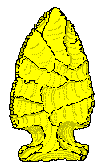
Early Archaic
Side Notched
Point

Early Archaic
Side Notched Point
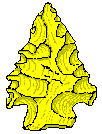
Early Archaic
Corner Notched
Point
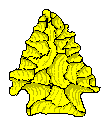
Early Archaic
Corner Notched
Point
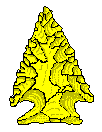
Early Archaic
Corner Notched
Point

Early Archaic
Bifurcate Base
Point

Early Archaic
Bifurcate Base
Point
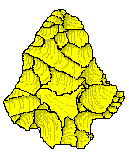
Early Archaic
Bifurcate Base
Point

Early Middle Archaic Point

Early Middle Archaic Point

Early Middle Archaic
Point
